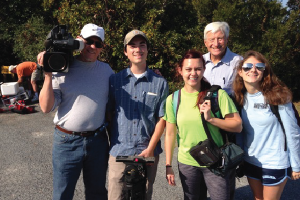Reporting on the environment

By Beth Hatcher
UNC Hussman Professor Tom Linden thinks every month should be Earth Month, not just April — especially given the myriad challenges currently facing the world’s environment.
Linden teaches students how to report about those environmental challenges in “MEJO 560: Environmental and Science Journalism” and “MEJO 562: Environmental & Science Documentary TV” courses. Both courses help students grow the necessary skills for environmental reporting.
“You’ve got to start with awareness,” Linden said. “And environmental awareness starts with carefully crafted stories that break down these complex issues into clear, concise language that enable people to understand the environmental crisis the world is facing.”
He described the crisis as climate change brought about by the world's reliance on fossil fuels that have led to more extreme weather events, rising seas and acidification of the ocean.
Linden, a physician journalist, started his journalism career as a reporter for the Los Angeles Times. Later after medical school and training as an adult and child psychiatrist, Linden started reporting on both medical and environmental issues on television. He currently serves as Hussman’s Glaxo Wellcome Distinguished Professor of Medical Journalism. Both the medical and science beats require a precision and attention to detail that all good science reporters need, Linden said.
Megan Suggs ’22 (M.A.) took “MEJO 560” during the fall 2021 semester and considers the course foundational to improving the writing skills that she hopes will land her a science communication job upon graduation.
“I wanted to get more experience writing about environmental topics,” Suggs said. “Specifically, I wanted to learn how to find interesting stories related to environmentalism and how to translate a scientist's words for the layperson. So many of today's problems intersect with science … understanding environmental problems and the science behind them can help people make decisions they feel are safest and most ethical.”
Fall 2021 “MEJO 560” students produced a website examining climate change as part of a collaborative international learning program (COIL) between UNC and the University of Navarra in Pamplona, Spain.
And for several semesters, Linden’s students have produced mini-documentaries about environment issues at North Carolina state parks in conjunction with PBS North Carolina, such as the piece below that focuses on the endangered Roanoke logperch along the Dan and Mayo Rivers near Mayo River State Park in Rockingham County, North Carolina.
Former student Patrick Mustain ’13, now a multimedia producer at Oceana, called the documentary work as a student an important step in his career development.
“In addition to getting some shooting experience, it also offered a glimpse into what goes into producing a short video documentary — how to find a story, find the characters you want to help tell it, and how to be thoughtful and methodical about planning shoots, the edit and final delivery,” Mustain said. “Also, having that clip for our reel, a package that was aired on state public television, was a great addition to my resumé.”
For Linden, knowing his courses have helped alumni like Mustain find professional success represent one of the most rewarding parts of being a professor. However, “MEJO 560” and “MEJO 562” aren’t just about teaching job skills but illuminating an issue that links to every part of the human experience. The health of the environment is a critical factor to the health and well-being of people worldwide.
“Our students are very aware that the environment is going to be one of the main issues of their lifetimes,” Linden said.